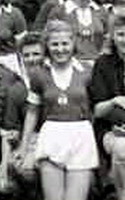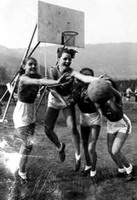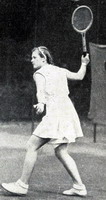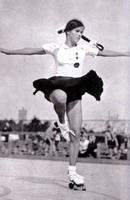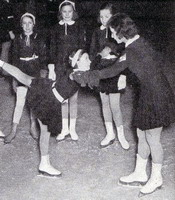While physical fitness did not play the important role in the League of German Girls that it did in the male Hitler Youth, it was still an integral part of the service, and one afternoon each week was devoted to sports and athletics in most BDM and Jungmaedel groups.
This generally included track and field events as well as gymnastics, but other sports were part of the program as well, based on what was available locally and drew interest. Girls were expected to be of healthy minds and bodies, and participation in the sports afternoon was just as mandatory as participation in regular group meetings.
→ Shirt & Shorts
→ Track Suit
→ Bathing Suit
→ Gymnastics Dress
→ Sport Shoes
→ Specialized Clothing
→ The Ski Uniform
Shirts and Shorts
 The basic sports uniform of the League of German Girls and the younger members of the Jungmaedel groups were originally identical to those used by the male Hitler Youth. The male sports shirt was later changed to include a horizontal red-white-red stripe, but those of the League of German Girls remained the same.
The basic sports uniform of the League of German Girls and the younger members of the Jungmaedel groups were originally identical to those used by the male Hitler Youth. The male sports shirt was later changed to include a horizontal red-white-red stripe, but those of the League of German Girls remained the same.
The basic sports uniform can be seen in the photo on the left, modeled by a young member.
The top consisted of a plain white cotton tank top with a molded collar. (This should not be confused with modern “ribbed” tank tops.)
The shorts were made of a black, very lightweight brushed cotton material, which often appears slightly shiny in some of the period photographs. The shine was caused by the types of dyes used to color the fabric. The shorts closed either with elastic or a drawstring at the top and did not have pockets. Some variations also had elastic at the leg openings, but those that did not, tended to ride up with wear.
BDM girls wore the Hitler Youth insignia centered on the chest of the white tank top, but especially with younger or new members, a lack of insignia was common. Certain types of national sports awards that came as a cloth badge could be worn with the uniform, and were usually worn on the lower left side of the shorts, but this was fairly uncommon.
The sports uniform was overall well liked and comfortable, and we see many period photographs where it is worn during down time at camp, or while working in the field during the service year. The sports uniform seems to be the League of German Girls’ equivalent of the current “uniform of summer” – shorts and a T-shirt. Packing lists of the country service year required girls to bring along one pair of gym shorts and at least one (preferably two) sports shirts with the Hitler Youth insignia. Girls also wore their BDM sports uniform to gym class at school so their parents did not have to buy an additional sports outfit.
Usually worn with the sports uniform was a pair of black leather gym shoes, which could be worn with, or without socks. Without socks was the more common style. You can read more about gym shoes further down on this page.
Tracksuit
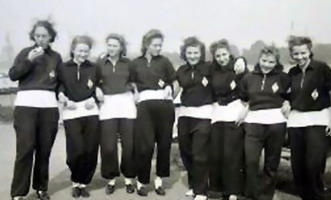 Groups of the League that did not have indoor sports facilities available to them often did not hold sports afternoons during the colder winter months, especially when snow and ice covered the ground, and therefore there’s no special “winter” sports uniform per se.
Groups of the League that did not have indoor sports facilities available to them often did not hold sports afternoons during the colder winter months, especially when snow and ice covered the ground, and therefore there’s no special “winter” sports uniform per se.
They did, however, have dark blue track suits that were worn during colder months as part of the sports uniform.
The track suit consisted of a pair of dark blue, almost black pants, which were cut fairly large to allow room for comfortable movement. They closed with either elastic or a drawstring at the waist, and with elastic at the ankles. Some variations had side pockets while others did not. Because of their wide cut, pants often looked ill-fitting or bulky. Worn with the pants was a dark bluew, long-sleeved top that had a half- zipper closure at the neck and a small collar. The jacket had elastic at the waist as well as at the wrists.
Most variations of the track suit resembled the black track suits worn by members of the SS, but another version existed that had buttons at the neck rather than a zipper, and a large patch pocket on the lower left side of the top. The zippered variety is the more common of the two.
The track suit did not usually have any insignia on it, although this varied by the different groups. Some groups, like the one in this photo, wore the Hitler Youth diamond on the lower left side of the top, and sometimes centered on the left sleeve. It was much more common, however, to see the track suit with no insignia at all. (Parents, after all, had to purchase all insignia and uniform pieces.)
The girls in the photo above are members of the Belief and Beauty society and are wearing their track suits over the gymnastics dress. Girls did not generally have their shirts hanging out as seen there since they wore their tank tops tucked into the shorts, both of which were worn underneath the track suit. The length and cut of the gymnastics dress made girls opt for wearing it over the sweat pants, rather than tucking it in.
Bathing Suit
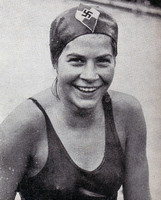 Because swimming required a public pool or other swimming facility nearby, not all groups of the League of German Girls offered swimming as part of their regular schedule, although girls were still encouraged to swim because it gave them a good full-body workout and was considered overall to be very healthy for growing girls.
Because swimming required a public pool or other swimming facility nearby, not all groups of the League of German Girls offered swimming as part of their regular schedule, although girls were still encouraged to swim because it gave them a good full-body workout and was considered overall to be very healthy for growing girls.
Even though not all groups offered swimming, the League of German Girls had a prescribed bathing costume, which is seen in the photo on the left.
The bathing suit consisted of a black or dark blue one-piece suit that was generally made from either cotton or wool. A light-weight wool or wool-blend (some synthetics such as rayon were used) was the more common variety. Because of the material, the suits did not stretch much and often were rather ill-fitting garments. Most suits had one shoulder strap that unbuttoned to make getting into the suit possible. You can see a button on the girl’s left shoulder in this photo.
Because suits were purchased privately and no actual guidelines existed other than that the suit was to be black or dark blue in color, we see a lot of variations of these – some have braided straps, others have different color buttons or colored trim along the sides. As a general rule, no insignia were worn on the bathing suit, although some groups used the Hitler Youth insignia centered on the chest.
A rubber bathing cap was an optional item (sometimes required by the particular public pool a group attended). The prescribed bathing cap was made from white rubber and when worn, would be covered with a black kerchief that had the cloth HJ insignia sewn to it, like the one seen in the photo on the left.
Gymnastics Dress
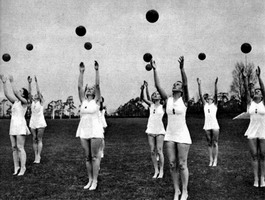 Like most of the work in the Belief and Beauty society, sports also focused on the more feminine aspects, and the girls were instructed in rhythmic gymnastics as well as eurhythmic dancing by teachers who were trained by the Medau school.
Like most of the work in the Belief and Beauty society, sports also focused on the more feminine aspects, and the girls were instructed in rhythmic gymnastics as well as eurhythmic dancing by teachers who were trained by the Medau school.
Hinrich Medau’s school of gymnastics has given a demonstration during the 1936 Olympics, and BDM leaders were so enamored with this new and different style of gymnastics that they requested Medau set up a routine for them, which he gladly did.
The new gymnastics outfit that was introduced for the young ladies of the Belief and Beauty society was similar in style to an old-fashioned bathing costume. It consisted of a sleeveless, thigh-length dress, which was worn over a pair of shorts that buttoned up on the side. Both the dress as well as the shorts were made from white cotton. The dress usually bore the Hitler Youth insignia centered on the chest, but sometimes is seen without the insignia as well.
Unlike other sports outfits of the League of German Girls, the gymnastics dress was always worn without any kind of sports shoes, and demonstrations were usually held on grass, or sometimes indoors.
Sport Shoes
 While their teenage counterparts in the United States mainly wore rubber-soled canvas tennis shoes, such as Converse or Keds athletic shoes, for sports, the most common footwear worn by members of the League of German Girls as well as the male Hitler Youth were black leather shoes such as the original pair seen on the left.
While their teenage counterparts in the United States mainly wore rubber-soled canvas tennis shoes, such as Converse or Keds athletic shoes, for sports, the most common footwear worn by members of the League of German Girls as well as the male Hitler Youth were black leather shoes such as the original pair seen on the left.
These athletic shoes were usually black in color and made of a very soft, thin leather. The construction of these shoes was fairly simple, and most had leather soles, although some examples of shoes with rubber soles exist as well. Lace-up shoes such as the pair pictured on the left were more common, but in some of the photos in the gallery you can see a wide variety of sport shoes worn. Some have a buckle over the top similar to modern Chinese slippers. Others are designed like gymnastics slippers and have elastic along the top edge to keep a snug fit, and a band across the top of the foot to keep from losing them.
Contemporary packing lists for leadership schools and camps recommend that shoes should preferably be sturdy in construction, black in color, and of the lace-up variety. The original pair seen on the left are from the webmaster’s collection.
Specialized Clothing
The League of German Girls offered girls a wide variety of sports and teams to chose from – almost any sport that you could think of was offered, from tennis and soccer, to fencing, horseback riding, field hockey, and even basketball. Most teams had uniforms for their sports, which varied from the regular sports uniforms of the BDM. To go into detail about all of them would be almost impossible, since these uniforms varied by teams, so the small selection below should give the researcher and student a general idea of the variety.
Most of the uniforms were black and white in color – whether this was a white polo shirt with a black skirt for roller-skating, or a white blouse and black pants for horseback riding, or even a white blouse and black jumper for field hockey. An exception to this are, of course, tennis and fencing outfits, which are traditionally white. On almost all of these uniforms we see the Hitler Youth diamond being worn, either on the chest or sleeve.
Ski Uniform
 The League of German Girls used a ski uniform, which, at first, consisted of a pair of dark blue wool ski pants and a khaki jacket that was later replaced by a dark blue wool jacket.
The League of German Girls used a ski uniform, which, at first, consisted of a pair of dark blue wool ski pants and a khaki jacket that was later replaced by a dark blue wool jacket.
During the time period the Leauge of German Girls existed, it was very uncommon for a woman or girl to wear long pants, and the only time women really wore pants was for skiing, hiking, riding, or sports in general. Even though sports pants were available, we still see photos of BDM girls in the middle of winter, wearing their skirts and nothing but a pair of thigh-high wool stockings to keep their legs warm.
The first BDM ski jacket was a pull-over style khaki, or “olive-grey”, jacket that was to be worn over the white blouse or wool clothing of the girl’s choice. It laced up at the neck and was supposed to be worn with the Gau triangle and the Hitler Youth insignia sewn on.
This early jacket was later replaced by a dark blue, double-breasted, hip length jacket with two side pocket, which was generally lined in a lighter blue rayon fabric, although liner fabrics and colors sometimes vary. You can see an example of a later BDM ski jacket in the photo on the right.
The bottoms of the ski outfit consisted of a pair of dark blue, side-button ski pants which had two hip pockets. In some instances we can also see the girls wearing male Hitler Youth ski pants, which are similar in style but featured a button fly and back pockets. The regulation girls’ ski trousers had two hip pockets which closed with two buttons each, and a button closure on the left hip that closed with six buttons. The buttons used on the ski uniform were identical in design to those of the white BDM blouse, but were dark blue in color.
Worn with the ski uniform was the so-called Teufelskappe, a black knit wool cap, which featured ear flaps that could be folded down over the ears. This wool cap was only worn by members of the Jungmaedel. Alternatively, and for the older girls, a dark blue headband of the girl’s choice could be worn.
In addition, regulations prescribed that socks, gloves, and scarves should be grey in color, but no “regulation” items existed for this purpose. Of a note here should be that the full “regulation” ski uniform as prescribed in the BDM’s manuals is nearly never seen in photos.




